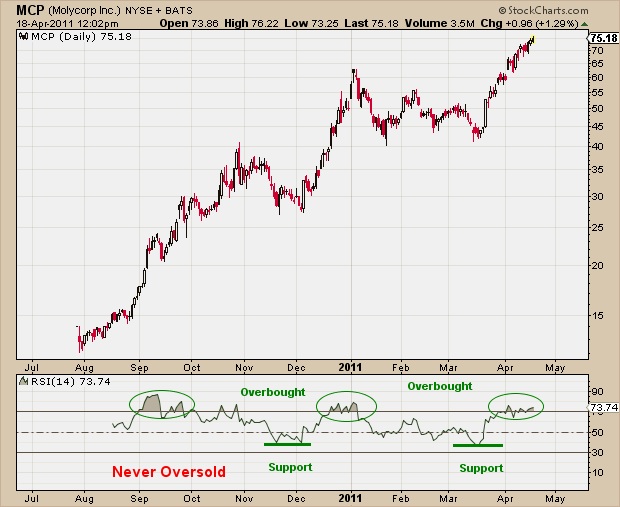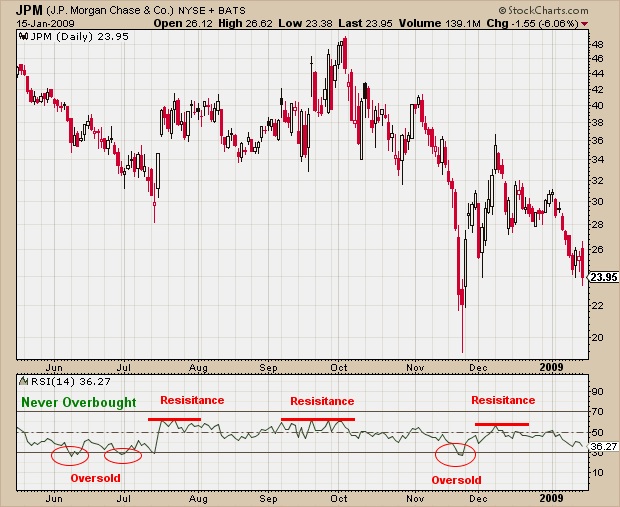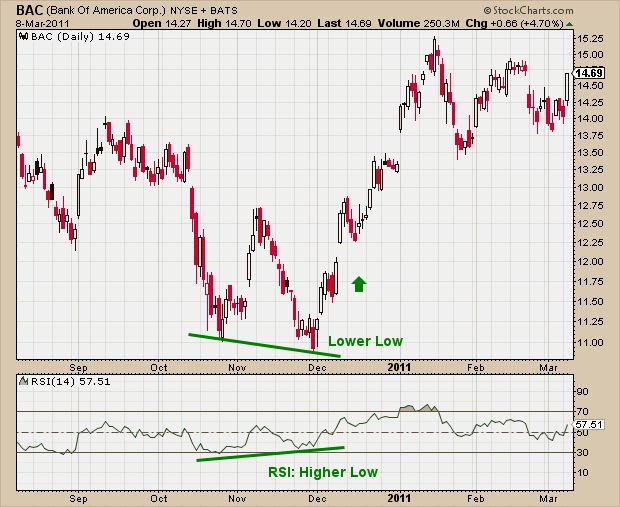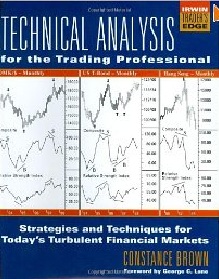RSI – Relative Strength Index
This originally appeared on May 3, 2011. I've noticed a lot of newcomers to the site. Enjoy and thanks for reading.
If you’ve been reading Allstarcharts you’ve seen me referencing RSI on a lot of my posts. I want to talk a little bit about the Relative Strength Index and how I use it. You’ll notice that I am not an “oscillator junkie”. You won’t see 27 momentum indicators on my charts. In fact, you will usually just find one: RSI (or the Relative Strength Index). Do not confuse the RSI with “Relative Strength”, which shows the performance of one security relative to another (i.e. Financials vs S&P500).
RSI is a momentum indicator that compares the magnitude of recent gains to recent losses in a range between 0-100. Instead of going into how J. Welles Wilder created the oscillator and how it works, I am going to focus on how I use it personally. Stockcharts.com does an incredible job of explaining it’s construction and Connie Brown takes RSI to the next level as good as anyone.
RSI has plenty of benefits to its users, but there are 2 primary ways that RSI helps my day-to-day charting. The first and easiest way is to watch for what “Mode” RSI is currently in. When the indicator is in Bullish Mode you will often see it reaching overbought levels and staying up there for a while. In addition, you should not see it fall below 35-40. Although we are told that 30 is oversold, and it is, the key area to watch for is 35-40 to make sure that the indicator is still in “Bullish Mode”.
The Chart above shows Molycorp ($MCP), a stock that has been on fire. You’ll notice that RSI continues to get overbought, however, during the consolidations and selloffs, RSI fails to reach oversold levels. This is exactly what I look for when trying to figure out which mode the security in question is in.
On the other hand, RSI is in Bearish Mode when it constantly gets oversold and cannot get above the 60-65 level. Resistance around there means trouble for whatever security we are trying to analyze. Below is a chart of JP Morgan ($JPM) from 2008, a perfect example of a stock in Bearish Mode. You will notice that Resistance was found at 60 again and again while constantly getting down to oversold levels. Take note that overbought levels were never reached during this decline. This is because RSI was never in Bullish Mode.
The Modes, if you will, are probably the easiest and most common sense ways that I like to use the Relative Strength Index. The second way that RSI helps me is through Divergences and Confirmations. What we like to see when a stock makes a new high is RSI also making a new high. When it doesn’t, this is what we call a “Bearish Divergence”. In other words, if XYX makes a higher high and RSI meanwhile makes a lower high, something is wrong. This is even more evident when these divergences occur at overbought levels, increasing the vulnerability of the security in question. On the flip side, when a stock is in a downtrend RSI should confirm a new price low by also making a new low. When that does not occur a “Bullish Divergence” is seen. In other words, a lower low in price with a higher low in RSI.
Below we can see that Bank of America ($BAC) in October made a new low in price and a new low in RSI. However in late November, RSI made a Higher low as the stock made a lower low. This Bullish Divergence was a heads up for a potential Bank of America Rally. Sure enough we saw close to a 40% move to the upside over the next 6 weeks.
Divergences, as noted above, work both ways. Just like a Bullish Divergence gives us insight into a potential rally, a Bearish Divergence is a warning of an impending decline. The chart below shows Apple ($AAPL) stock making a new high in price December of 2007 while RSI made a lower high. We all see what happened after that. Notice that the divergence came from RSI being overbought throughout October and early November but could not reach those levels in December when the price was making new highs.
RSI is a great tool. A lot of traders use it a lot of different ways. I personally like the, “Keep it Simple Stupid” approach when it comes to my Technical Analysis so I use the divergences to help with risk management and setting up nice risk vs reward opportunities. Remember that no single indicator should be used in isolation. As my friend Brian Shannon from Alphatrends always says, Only Price Pays. But if you can use a reliable indicator to supplement price action, then go for it. These simple clues that RSI gives us can really go a long way. If you want to get more information on RSI, and come up with your own strategies, these books are probably a good place to start.





